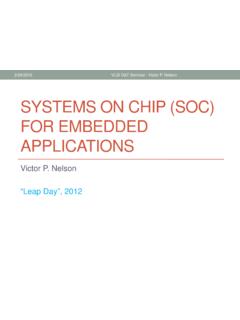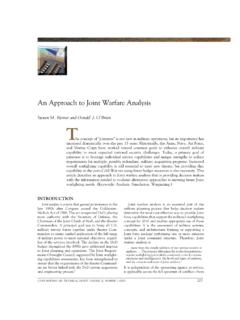Transcription of Planning process Reference designs A practical guide to ...
1 1. Introduction2. PlanPlanning processReference designsCost analysis 3. DesignProcessSite selection4. Best practice and success storiesUniversity of Texas, AustinGreen MountainSagrada Familia5. ConclusionA practical guide to data center Planning and designA practical guide todata center Planning and design1. Introduction2. PlanPlanning processReference designsCost analysis 3. DesignProcessSite selection4. Best practice and success storiesUniversity of Texas, AustinGreen MountainSagrada Familia5. ConclusionA practical guide to data center Planning and designIn today s world of being on 24/7, data centers are at the core of business and viewed as the way to create competitive differentiation. Speed, efficiency, flexibility, and scale are now critical for winning the race to meet new connectivity and processing demands caused by the Internet of Things (IoT) and Big centers enable the right insight to make better business decisions.
2 They have come a long way from simply keeping the lights while the value and role of data centers have changed, the way most people design them has not. Historically each build started from scratch and, while it s true that each data center project has unique needs, they also have a lot in common and there is much to be gained by taking advantage of these , Planning data center projects remains a major challenge. Plans are often poorly communicated among stakeholders, and minor changes can result in major cost consequences further down the road. Planning mistakes often propagate through later deployment phases, resulting in delays, cost overruns, wasted time and, potentially, a compromised to worry Schneider Electric has put together practical steps that include clear methodologies, at-a-glance calculators and tools, and a comprehensive library of Reference designs to simplify and shorten your Planning process while improving the quality of the data centers continue to expand and evolve, a flexible design approach will help grow business quickly without excessive capital outlay or overbuilding.
3 Data center Reference design tools will help you avoid many of the common pitfalls and with adaptable, modular options it s possible to future-proof your data center while meeting your current business goals (and budget).21. IntroductionSHARE THIS1. Introduction2. PlanPlanning processReference designsCost analysis 3. DesignProcessSite selection4. Best practice and success storiesUniversity of Texas, AustinGreen MountainSagrada Familia5. ConclusionA practical guide to data center Planning and designThe plan phase in the context of the data center life cycle, showing the key plan tasks:3An obvious but often overlooked concept, data center Planning and design must be done in the right order from the outset. When the right decision makers are given the right information in the right sequence the project will run more smoothly and possibly even exceed expectations.
4 Rather than presenting excruciating detail or an ambiguous outline without enough information, proper Planning turns overwhelming or vague requirements into complete blueprints. And it doesn t have to be time consuming or frustrating. The Schneider Electric project process for the data center life cycle includes a standardized plan phase, which consists of four tasks around the physical infrastructure, laying the foundation for everything that follows. 1. Establish key project parameters to control the system architecture and budget. Start by identifying a business need. Then determine the project parameters around criticality, capacity, growth, efficiency, density, and budget. These six key project factors set the high-level goals of the project. Overall goal of step 1: Ensure scarce executive time is applied to important decisions.
5 Stakeholders: Finance, CEO, IT Executive, IT Operations Manager; Key Lines of Business Leaders2. Plan: Planning processBuildDesignPlanAssessOperateWhat am I going toimprove/build?Who willmanage myconstruction?How do Ioperate at optimumlevels?What are my best options?Where am I now?Data centerlife cycleservices1. Introduction2. PlanPlanning processReference designsCost analysis 3. DesignProcessSite selection4. Best practice and success storiesUniversity of Texas, AustinGreen MountainSagrada Familia5. ConclusionA practical guide to data center Planning and design42. Develop a system concept. The cornerstone of this task is the selection of a Reference design . While there are a significant number of possible Reference designs , the six key project parameters will quickly rule most of them out.
6 Once you ve narrowed it down to a few, review them for additional considerations such as logistics and vendor goal of step 2: Choose a general concept of physical infrastructure. Stakeholders: IT Operations, IT Executive, Facilities Executives, Facility Engineer, Experienced Consultant3. Incorporate user preferences and include technical design requirements that are not part of the six key project parameters. But, rather than collect these upfront and use them to drive the overall design , it s much more efficient to adapt user preferences and constraints after the design concept has been chosen. Otherwise, you re more likely to steer away from standard designs , driving up cost and deployment goal of step 3: Make concept adaptations to avoid reconsidering the system concepts.
7 Stakeholders: IT Operations, Network Engineers, Facilities Engineers, Data Center Managers, Experienced Consultant4. Determine implementation involves collecting standards, codes, deadlines, resource assignments, and process requirements. Standard requirements include regulatory compliance standards, subsystem compatibility, safety, and best practices. Project requirements include deadlines, vendors that must be used, and special procurement or other administrative processes. Separating requirements into these two buckets will simplify the job of creating a detailed system goal of step 4: Create a set of rules to be followed above and beyond the outputs of the previous three : Engineers, Plan: Planning process (cont.)1. Introduction2. PlanPlanning processReference designsCost analysis 3.
8 DesignProcessSite selection4. Best practice and success storiesUniversity of Texas, AustinGreen MountainSagrada Familia5. ConclusionA practical guide to data center Planning and design5As outlined earlier, the approach to data center design hasn t changed much over the years. Historically, each build was considered custom and started from scratch. However, although each data center has exclusive needs, there are also a lot of commonalties. With the call for faster Planning and building and the reality of tighter budgets, fewer staff, uncertain IT loads, and a need for high availability, it s no longer practical or cost effective to engineer all aspects of a data center uniquely. There is much to gain from the reuse of proven, documented subsystems or Plan: Reference designsData center projects: Advantages of using a Reference designReference designs are often used in home construction.
9 Regardless of the level of customization, using a Reference design can be beneficial, albeit to varying home planReference design only Very fast Very repeatable Very predictable performance, cost, all three plans benefit from using a Reference home planBase design by domain, heavily adapted Faster than starting from scratch Repeatable domains kitchens, rooms, garage Less predictable performance, cost, and scheduleSemi-custom home planReference design with custom finishing elements Fast Repeatable but with custom finishes Predictable performance, cost, schedule1. Introduction2. PlanPlanning processReference designsCost analysis 3. DesignProcessSite selection4. Best practice and success storiesUniversity of Texas, AustinGreen MountainSagrada Familia5.
10 ConclusionA practical guide to data center Planning and design6 This is why Schneider Electric has mapped out a simplified way to plan, design , build, operate, and assess with data center Reference designs . A Reference design is a system blueprint with a list of attributes, such as system-level performance specifications, along with materials and components. This design could be for a complete data center or for a subsection of the data center, such as an IT pod, IT room, power plant, or cooling decades of thought leadership in building data centers, our Reference designs are based on best practices what has and hasn t worked in the thousands of data centers we ve built over the years. Our catalog of designs enables you to quickly find those that best fit your requirements with minimal adaptations, helping you plan faster, reduce possible risks, and reliably predict future performance.




![arXiv:1301.3781v3 [cs.CL] 7 Sep 2013](/cache/preview/4/d/5/0/4/3/4/0/thumb-4d504340120163c0bdf3f4678d8d217f.jpg)